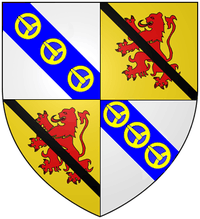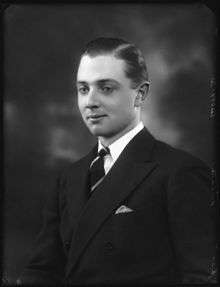Earl of Rothes


19th Earl of Rothes.
Earl of Rothes (pronounced "Roth-is") is a title in the Peerage of Scotland. It was created in 1458 for George Leslie, 1st Lord Leslie. He had already been created Lord Leslie in 1445, also in the Peerage of Scotland. His grandson, the third Earl, having only succeeded his elder brother in March 1513, was killed at the Battle of Flodden on 9 September of the same year. His son, the fourth Earl, served as an Extraordinary Lord of Session. Lord Rothes was also tried for the murder of Cardinal Beaton but was acquitted.
His great-great-grandson, the seventh Earl, was a prominent statesman. He was notably Lord High Treasurer of Scotland from 1663 to 1667 and Lord Chancellor of Scotland from 1667 to 1681. In 1663 he obtained a new charter conferring the earldom of Rothes and lordship of Leslie (which was regranted as Lord Leslie and Ballenbreich), in default of male issue of his own, on his eldest daughter Margaret, wife of Charles Hamilton, 5th Earl of Haddington, and her descendants male and female. It was stipulated in the charter that the earldoms of Rothes and Haddington should never be allowed to merge. In 1680 Lord Rothes was further honoured when he was made Lord Auchmotie and Caskieberry, Viscount of Lugtoun, Earl of Leslie, Marquess of Bambreich and Duke of Rothes, with normal remainder to the heirs male of his body. These titles were also in the Peerage of Scotland.
The Duke had no sons and on his death in 1681 the creations of 1680 became extinct. He was succeeded in the earldom of Rothes and the lordship of Leslie and Ballinbreich according to the charter of 1663 by his daughter Margaret, the eighth holder. Her husband Lord Haddington was succeeded by their second son Thomas (see the Earl of Haddington for more information on this title) while Margaret was succeeded by their eldest son John, the ninth Earl. He assumed the additional surname of Leslie and sat in the British House of Lords as a Scottish Representative Peer between 1708 and 1710. His son, the tenth Earl, was a Lieutenant-General in the Army and notably served as Commander-in-Chief of the Forces in Ireland. From 1723 to 1734 and from 1747 to 1767 he was a Scottish Representative Peer in the House of Lords.
His son, the eleventh Earl, died unmarried at an early age and was succeeded by his eldest sister Jane Elizabeth, the twelfth holder of the titles. She was the wife of George Raymond Evelyn. Their son, the thirteenth Earl, served as a Scottish Representative Peer from 1812 to 1817. Lord Rothes assumed the surname of Leslie in lieu of Evelyn. He was succeeded by his daughter Henrietta Anne, the fourteenth holder. She was the wife of George Gwyther who along with his wife assumed the surname of Leslie. Their grandson, the sixteenth Earl (who succeeded his father) died unmarried at a young age and was succeeded by his sister Henrietta, the seventeenth holder. She was wife of the Hon. George Waldegrave, younger son of William Waldegrave, 8th Earl Waldegrave.
- They had no children and Henrietta was succeeded by her aunt Mary Elizabeth, the eighteenth holder. She was the second daughter of Henrietta Anne, the fourteenth holder, and the wife of Captain Martin Edward Haworth, who in 1886 assumed for himself and his family by Royal licence the additional surname of Leslie. Their grandson, the nineteenth Earl, sat in the House of Lords as a Scottish Representative Peer between 1906 and 1923. The wife of the 19th Earl, Lucy Noël Martha Leslie, Countess of Rothes, is best known as a survivor of the sinking of RMS Titanic in 1912. His son, the twentieth Earl, was a Scottish Representative Peer from 1931 to 1959. As of 2017 the titles are held by his grandson, the twenty-second Earl, who succeeded his father in 2005.
The courtesy title used by an heir apparent to the earldom is Lord Leslie.
The family seat is Littlecroft, near West Milton, Dorset.
Earls of Rothes (1457)
- George Leslie, 1st Earl of Rothes (c. 1417–1490)
- George Leslie, 2nd Earl of Rothes (d. 1513)
- William Leslie, 3rd Earl of Rothes (d. 1513)
- George Leslie, 4th Earl of Rothes (d. 1558)
- Andrew Leslie, 5th Earl of Rothes (d. 1611)
- John Leslie, 6th Earl of Rothes (d. 1641)
- John Leslie, 7th Earl of Rothes (c. 1630–1681)
Dukes of Rothes (1680)
- John Leslie, 1st Duke of Rothes (c. 1630–1681)
Earls of Rothes (1457; reverted)
- Margaret Leslie, 8th Countess of Rothes (d. 1700)
- John Hamilton-Leslie, 9th Earl of Rothes (d. 1722)
- John Leslie, 10th Earl of Rothes (d. 1767)
- John Leslie, 11th Earl of Rothes (1744–1773)
- Jane Elizabeth Leslie, 12th Countess of Rothes (1750–1810)
- George William Evelyn-Leslie, 13th Earl of Rothes (1768–1817)
- Henrietta Anne Evelyn-Leslie, 14th Countess of Rothes (1790–1819)
- George William Evelyn Leslie, 15th Earl of Rothes (1809–1841)
- George William Evelyn Leslie, 16th Earl of Rothes (1835–1859)
- Henrietta Anderson Morshead Leslie, 17th Countess of Rothes(1832–1886)
- Mary Elizabeth Leslie, 18th Countess of Rothes (1811–1893)
- Norman Evelyn Leslie, 19th Earl of Rothes (1877–1927)
- Malcolm George Dyer-Edwardes Leslie, 20th Earl of Rothes (1902–1974)
- Ian Lionel Malcolm Leslie, 21st Earl of Rothes (1932–2005)
- James Malcolm David Leslie, 22nd Earl of Rothes (b. 1958)
The heir presumptive is the present holder's only brother, Hon. Alexander John Leslie (b. 1962).
Gallery of Earls
 1. George Leslie [1458-1490] (COA, no known depicitons)
1. George Leslie [1458-1490] (COA, no known depicitons) 2. George Leslie [1490-1513] (COA, no known depictions)
2. George Leslie [1490-1513] (COA, no known depictions) 3. William Leslie [1513] (COA, no known depictions)
3. William Leslie [1513] (COA, no known depictions) 4. George Leslie [1513-1558] (COA, no known depictions)
4. George Leslie [1513-1558] (COA, no known depictions) 5. Andrew Leslie [1558-1611
5. Andrew Leslie [1558-1611 6. John Leslie [1611-1641
6. John Leslie [1611-1641 7. John Leslie, the 7th Earl & 1st Duke [1641-1680,] [1680-1681
7. John Leslie, the 7th Earl & 1st Duke [1641-1680,] [1680-1681 8. Margaret Leslie [1681-1700
8. Margaret Leslie [1681-1700 9. John Hamilton-Leslie [1700-1722
9. John Hamilton-Leslie [1700-1722 10. John Leslie (General of the Army) [1722-1767
10. John Leslie (General of the Army) [1722-1767.jpg) 11. John Leslie (or his brother) [1767-1773
11. John Leslie (or his brother) [1767-1773 12. Jane Elizabeth Leslie [1773-1810
12. Jane Elizabeth Leslie [1773-1810 13. George William Evelyn-Leslie [1810-1817
13. George William Evelyn-Leslie [1810-1817 14. Henrietta Anne Evelyn-Leslie [1817-1819
14. Henrietta Anne Evelyn-Leslie [1817-1819 15. George William Evelyn Leslie [1819-1841
15. George William Evelyn Leslie [1819-1841 16. George William Evelyn Leslie [1841-1859
16. George William Evelyn Leslie [1841-1859 17. Henrietta Anderson Morshead Leslie [1859-1886
17. Henrietta Anderson Morshead Leslie [1859-1886 18. Mary Elizabeth Leslie [1886-1893
18. Mary Elizabeth Leslie [1886-1893 19. Norman Evelyn Leslie [1893-1927
19. Norman Evelyn Leslie [1893-1927 19. Malcolm George Dyer-Edwardes Leslie [1927-1974
19. Malcolm George Dyer-Edwardes Leslie [1927-1974 21. Ian Lionel Malcolm Leslie [1974-2005
21. Ian Lionel Malcolm Leslie [1974-2005 22. James Malcolm David Leslie [2005-
22. James Malcolm David Leslie [2005-.png) 23. Alexander Leslie (heir), Lord Leslie since 2005
23. Alexander Leslie (heir), Lord Leslie since 2005
Notes
- ↑ Debrett's Peerage, 1968, p.958
References
- Kidd, Charles, Williamson, David (editors). Debrett's Peerage and Baronetage (1990 edition). New York: St Martin's Press, 1990,
- Leigh Rayment's Peerage Pages
- Lundy, Darryl. "FAQ". The Peerage.